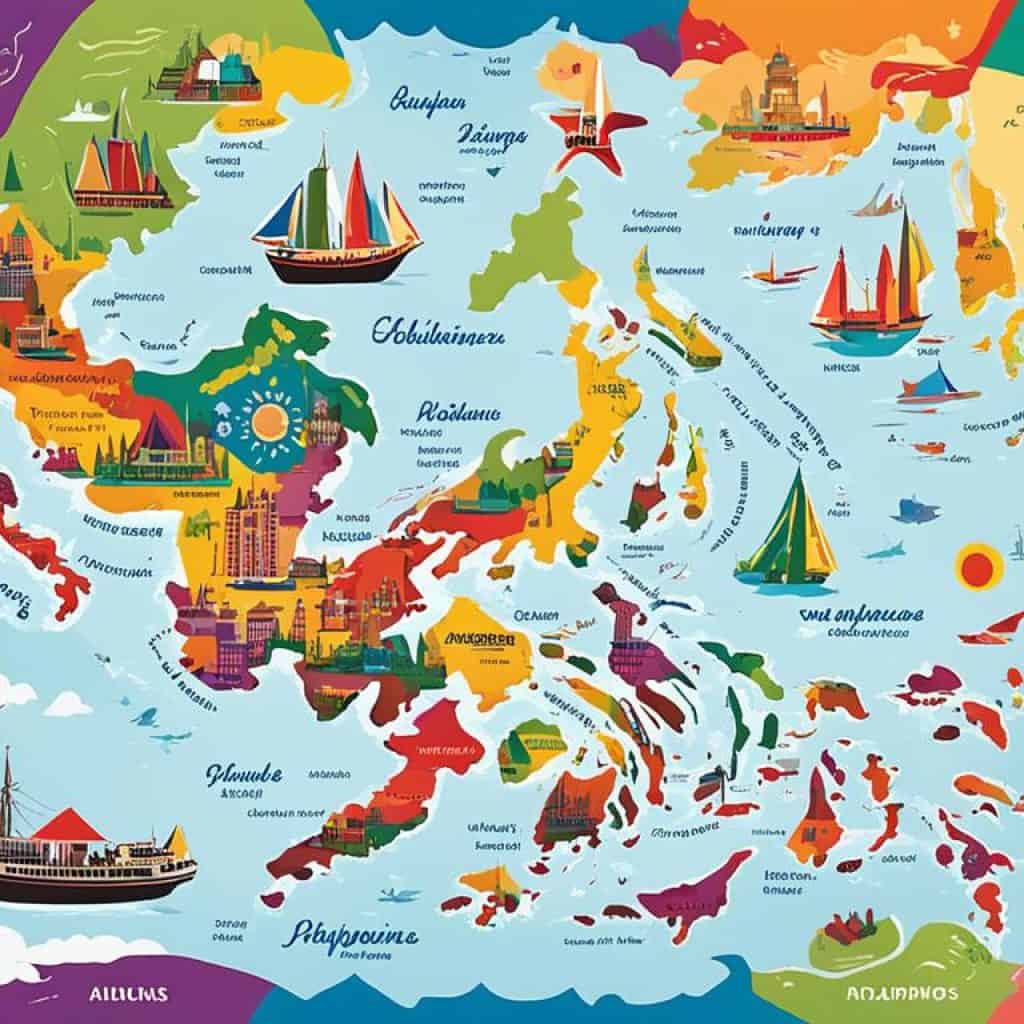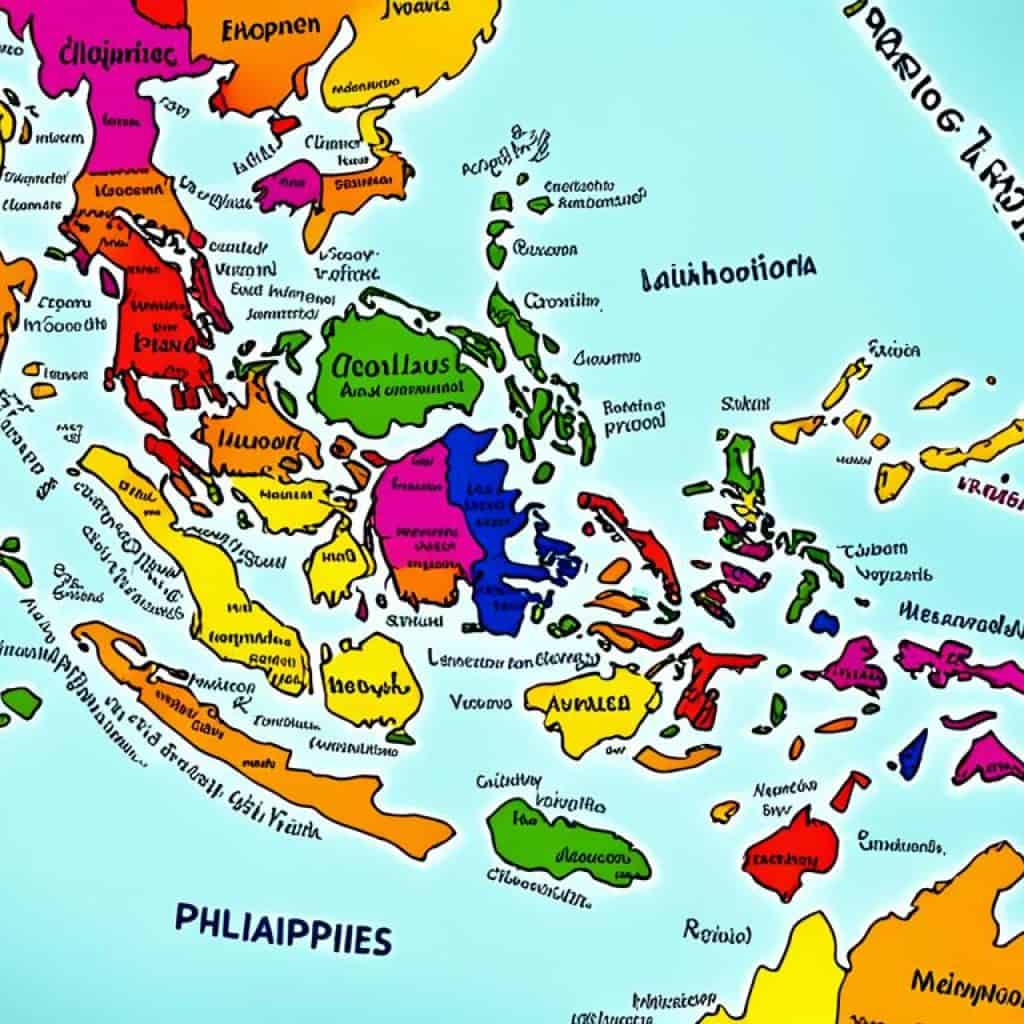Have you ever wondered about the Filipino language? What makes it different from other languages and dialects in the Philippines? Let’s go on a journey to explore Filipino, the Philippines’ national language, mainly based on Tagalog. We’ll discover interesting facts and insights. These help us understand the culture of this beautiful archipelago.
Key Takeaways:
- Filipino is the national language of the Philippines, based primarily on Tagalog.
- The Philippines has a rich linguistic landscape with various languages and dialects.
- Tagalog vowels have unique sounds, and understanding them is vital for proper pronunciation.
- Short and long vowels in Tagalog can significantly impact the meaning of words.
- Languages like Spanish and English have influenced the Filipino language over time.
Native Tagalog Vowels
Native Tagalog words have 5 vowels: ‘a,’ ‘e,’ ‘i,’ ‘o,’ and ‘u.’ They sound different from English vowels. Knowing these sounds helps master Tagalog pronunciation.
Tagalog vowels sound unique. It’s important to learn these sounds well. This makes your spoken Tagalog clear and understandable.
| Vowel | Pronunciation |
|---|---|
| a | a |
| e | eh |
| i | ee |
| o | oh |
| u | oo |
To speak Tagalog well, focus on vowel pronunciation. Practice speaking words and listen to native speakers. This improves your pronunciation.
Remember, pronouncing Tagalog vowels correctly is key to good communication. Love the unique sounds to dive into the language.
Next time you see a Tagalog word, notice the vowels. Understanding their sounds puts you on the path to fluency.
Short Tagalog Vowels
Short Tagalog vowels are pronounced quickly. They are crucial in basic Tagalog words. Mastering them helps achieve fluency.
These vowels include ‘a,’ ‘e,’ ‘i,’ ‘o,’ and ‘u.’ They sound different from English ones. Attention and practice are key to getting them right.
The vowel ‘a,’ said as **/ä/**, is in “bahay” (house) and “lalaki” (man). The ‘e,’ said as **/ɛ/**, is in “bente” (twenty) and “kape” (coffee).
Practicing these vowels is essential for Tagalog fluency. A solid grasp of them opens the door to understanding the language.
Benefits of Mastering Short Tagalog Vowels
Knowing how to pronounce these vowels has many perks:
- It improves talking. This lets you speak clearly with Tagalog speakers.
- It helps understanding. You’ll get spoken and written Tagalog better.
- It shows respect for Filipino culture and language.
- And it boosts your confidence. This helps connect with Tagalog speakers deeply.
Common Short Tagalog Vowel Pronunciations
| Short Vowel | Pronunciation | Examples |
|---|---|---|
| a | /ä/ | “bahay” (house), “lalaki” (man) |
| e | /ɛ/ | “bente” (twenty), “kape” (coffee) |
| i | /i/ | “isda” (fish), “dikit” (close) |
| o | /o/ | “boto” (vote), “kotse” (car) |
| u | /u/ | “bulaklak” (flower), “kuripot” (stingy) |
Learning these pronunciations boosts your Tagalog skills.
Don’t forget: practice is vital. Regularly speaking with Tagalog speakers helps master these vowels and improves fluency.
Long Tagalog Vowels
Long Tagalog vowels are vital in the Filipino language. They use a doubled vowel letter and are held longer than short vowels. This difference is crucial for clear speaking and understanding.
The length of a vowel can change a word’s meaning in Tagalog. For instance, “bata” means “child,” but “báta” with a longer “a” refers to “young coconut.” It’s essential to pronounce long vowels correctly to communicate effectively.
Long Tagalog vowels:
- a – pronounced as “ah”
- e – pronounced as “eh”
- i – pronounced as “ee”
- o – pronounced as “oh”
- u – pronounced as “oo”
When saying words with long vowels, ensure they are the right length. Practicing these sounds improves speech clarity and naturalness.
“Pronouncing long vowels correctly in Tagalog is key to mastering the language. It ensures clear communication and the right meaning of words.”
Pronunciation Tips for Tagalog Vowels
Improving your Tagalog vowel pronunciation is key to speaking fluently. Clear pronunciation is essential for understanding. Here are tips to enhance your pronunciation:
1. Listen to native speakers
Listening to native speakers is a great way to get better. Pay close attention to their pronunciation. Tagalog songs, podcasts, or movies can also help you hear different accents.
2. Practice repeating vowel sounds
Practice the Tagalog vowel sounds regularly. Repeat each sound distinctly. Online guides with audio examples can help. Practice words with each vowel sound to improve.
3. Master the short and long vowels
Tagalog has short and long vowels. Short vowels are brief, while long vowels last longer. Understanding the difference is important for accurate word pronunciation. Practice distinguishing between these vowels for fluency.
4. Enunciate each vowel sound
Enunciate each Tagalog vowel sound clearly. Clear pronunciation aids understanding and improves fluency. Focus on your tongue placement and lip position for each vowel sound.
5. Seek feedback and practice regularly
Get feedback from native speakers or teachers on your pronunciation. Their insights can help you improve. Regular practice strengthens pronunciation skills. Dedicate time daily for practice with Tagalog vowels.
By following these tips and practicing regularly, you’ll improve your Tagalog vowel pronunciation and fluency.
Additional Resources
Languages Spoken in the Philippines
The Philippines has a wide variety of languages. This shows the country’s rich cultural and linguistic heritage. It highlights the different identities of its communities.

1. Filipino Language:
The Filipino language comes from Tagalog and is the national language. It is spoken by many and brings Filipinos together. It is used in schools, government, and media.
2. Cebuano Language:
Cebuano, also called Bisaya, is the second most common language in the Philippines. It is mainly used in the Visayas and Mindanao. The language has several dialects, showing regional differences.
“The linguistic diversity of the Philippines is a testament to the country’s rich cultural heritage and the different communities that call it home.” – Language expert, Maria Santos
3. Other Regional Languages:
Besides Filipino and Cebuano, there are many regional languages in the Philippines. Languages like Ilocano, Hiligaynon, Waray-Waray, Pangasinan, Bicolano, and Kapampangan are also spoken. Each language adds to the country’s diverse linguistic scene.
Here is a table of the top five languages in the Philippines:
| Language | Number of Speakers |
|---|---|
| Filipino | Over 90 million |
| Cebuano | Over 20 million |
| Ilocano | Over 7 million |
| Hiligaynon | Over 5 million |
| Waray-Waray | Over 3 million |
These languages and dialects show the Philippines’ rich language scene.
Learning about these languages offers a glimpse into the nation’s varied cultures and traditions.
Spanish Influence on Philippine Languages
Over 300 years of Spanish rule deeply affected Philippine languages. It introduced many Spanish words into the native tongues. These words cover topics like religion, law, arts, and daily life[1].
“The influence of Spanish on Philippine languages is undeniable. The loanwords not only contribute to the vocabulary but also reflect the cultural exchanges between Spain and the Philippines.”
Many Filipino words are from Spanish. Words like “kamisa” for shirt, “mesa” for table, and “silya” for chair show the connection[2].
Even though not many in the Philippines speak Spanish now, its impact is still felt. Spanish surnames are common in the Philippines, showing the deep ties between both cultures.
The Spanish impact is a big part of the country’s culture and language. It shows how Spanish rule has left a mark on the Philippines.
| Spanish Loanwords | Native Language |
|---|---|
| Simbahan | Tagalog |
| Kutsara | Cebuano |
| Avenida | Ilocano |
| Trabaho | Hiligaynon |
Table: Examples of Spanish Loanwords in Philippine Languages[3]
These words link the past to the present. They show the continuous cultural connection between Spain and the Philippines. It’s a sign of the rich language heritage and ongoing preservation of the country’s diverse languages.
References
- Spanish Influence on Filipino Culture and Language. (n.d.). Retrieved from https://www.pineapple.news/enlifestyle/index/12720/15
- Pagkakatulad ng mga Salitang Kastila at Filipino. (n.d.). Retrieved from https://agimat.net/linggo-ng-wika/2020/08/10/mga-salitang-kastilang-tinanggap-sa-pilipino-terminolohiya
- Examples of Spanish Loanwords in Philippine Languages. (n.d.). Retrieved from https://www.rappler.com/life-and-style/arts-and-culture/158390-spanish-loan-words-filipino-languages
English as a Language in the Philippines
English is a vital language in the Philippines. It is an official language, alongside Filipino. It arrived during the American colonial period. Now, it’s used in government, education, and business. This makes the Philippines a major English-speaking country.
Many Filipinos are very good at English. This lets them talk and work with people worldwide. Being good at English helps Filipinos find jobs abroad and study in other countries.
“English proficiency is not only our competitive advantage but also an enabler for our people to connect and compete with their counterparts from around the world.” – Ramon M. Lopez, Secretary of the Department of Trade and Industry
English is important for its global status. Knowing English gives Filipinos access to many educational resources, helps in international business, and allows cultural exchanges. It helps understand people from other places.
English is also part of the school system in the Philippines. It gives students the language skills they need for today’s world. Being fluent in English opens a lot of doors in careers and lets Filipinos join the global workforce.
English in the Philippines is not just for talking. It gives people power, helping them grow and succeed in a global society.
Indigenous and Endangered Languages in the Philippines
The Philippines has a wealth of languages. Across its islands, many indigenous languages are spoken. These languages are tied to the traditions and heritage of various indigenous communities. They offer unique views into the Philippines’ history, culture, and identity. But, many of these languages are at risk of disappearing.
People are working hard to save and bring back these languages. They see how important it is to keep the country’s cultural heritage alive. Language experts, community members, and organizations are coming together. They’re working on language projects, making learning materials, and starting initiatives to keep languages alive.
Keeping these languages alive is crucial for the Philippines’ cultural identity. Saving indigenous languages keeps linguistic diversity intact. It also helps us appreciate indigenous cultures more. These languages link the past to the present. They connect communities to their history and traditional knowledge.
To save their languages, communities need to lead the way. It’s important that young people can learn these languages. By doing this, the Philippines honors its diversity. It also builds a stronger sense of who they are culturally.
The Importance of Language Preservation
“Language preservation is not only about preserving words; it is about preserving an entire cultural universe. Each language is a unique expression of a community’s identity, knowledge, and worldview.”
Language preservation includes making dictionaries and grammar guides. It also involves creating materials for learning languages. Groups led by communities, language schools, and cultural organizations are all key. They help keep language preservation going in the Philippines.
By valuing their languages and working to keep them alive, the Philippines shows its dedication to its linguistic diversity. This ensures these valuable cultural gems are cherished and continue to thrive.
| Indigenous Language | Region | Status |
|---|---|---|
| Ibaloi | Cordillera Administrative Region | Endangered |
| Tausug | Autonomous Region in Muslim Mindanao | Endangered |
| Kapampangan | Central Luzon | Endangered |
| Kinaray-a | Western Visayas | Endangered |
| Waray-Waray | Eastern Visayas | Endangered |
| Isinay | Cagayan Valley | Endangered |
The History of Filipino Language
The history of the Filipino language ties closely with the Philippines’ own history. It is mainly derived from Tagalog and has become the Philippines’ national language. During its growth, the Filipino language absorbed elements from Spanish and English colonization. These influences have shaped its words and structure.
Spanish impact on the Filipino language stands out significantly. Because of over 300 years under Spanish rule, many Spanish words blended into Filipino. This mix enriched its vocabulary, showcasing the deep cultural exchange between Spain and the Philippines. These Spanish words are common in topics like religion, law, art, and daily life.
This image shows how Spanish culture and the Filipino language are intertwined. It highlights the role of Spanish in shaping Filipino.
It’s key to differentiate between Filipino and Tagalog. Though Tagalog is the base for Filipino, the latter also includes words from other Philippine languages. This makes Filipino broader and more reflective of the country’s language diversity.
English has also left its mark on Filipino, introduced during America’s colonial rule. Nowadays, many people in the Philippines speak English. This has added to the country’s rich linguistic tapestry.
As the Philippines grows, the Filipino language evolves too. It changes with society, embracing new cultural and global influences. The Filipino language’s history is a story of resilience and change. It’s a vital part of the Filipino heritage and identity.
Language Diversity in the Philippines
The Philippines is rich in languages, with over 170 types spoken. This shows the country’s varied culture and communities. It’s a place of linguistic wealth.
Filipino and Cebuano are the main languages here. Filipino is the national language, coming from Tagalog. It connects people from different areas. Cebuano, or Bisaya, is next in line. It’s mainly spoken in the Visayas and Mindanao.
There are also many regional dialects. They are found in various provinces and islands. These dialects highlight the country’s linguistic diversity. Each has its own area, showing local culture and history.
The many languages in the Philippines show its rich past and diverse society. They are key to identity, history, and heritage. The Philippines’ languages make it a unique and interesting place for linguistics.

Regional Dialects in the Philippines
Here are some regional dialects from different Philippine areas:
| Region | Regional Dialect |
|---|---|
| Visayas | Hiligaynon/Ilonggo, Waray-Waray, Cebuano/Bisaya |
| Mindanao | Maguindanaoan, Tausug, Maranao |
| Northern Luzon | Ilocano, Pangasinense, Kapampangan |
| Bicol Region | Bikol, Rinconada Bikol, Masbateño |
The regional dialects in the Philippines add to its linguistic mix. They show the country’s cultural richness. These dialects reveal the traditions and history of different areas. They make the Philippines full of cultural discoveries.
The Significance of Language in Philippine Culture
Language is very important in Philippine culture. It helps express identity and keep traditions alive. The Philippines has many languages and dialects, showing its rich culture.
Each language and dialect is unique to a community. They help create the Philippines’ cultural fabric. These languages are key in shaping who we are. They range from Tagalog’s lyrical sounds to Cebuano’s rhythmic beats, highlighting the Philippines’ diversity.
It’s crucial to keep these languages alive for future generations. Efforts to preserve language aim to maintain the culture within dialects. This helps to save our linguistic heritage for years ahead.
“Language is the vessel through which culture flows, carrying with it the history, stories, and traditions of a people.”
Preserving language shows that it’s more than a way to talk—it helps us understand different communities. By doing this, the Philippines values diversity. It lets communities share their heritage with pride.
Keeping a language alive helps preserve a culture. The work done to save these languages shows the Philippines’ dedication to its culture.
A Closer Look: Language Revitalization
Efforts to revive endangered languages in the Philippines are ongoing. This includes recording stories, making learning resources, and getting communities involved. These steps help bring back native languages.
Language as Identity
Language deeply reflects who we are. It shows our beliefs, values, and norms. For many Filipinos, language connects them to their roots and heritage.
Preserving the Past, Enriching the Future
Keeping languages alive is key to maintaining cultural traditions. This way, the Philippines honors its history. And it builds a future that values diversity and culture.
Language Education in the Philippines
Language education is key in the Philippines. It gives students a strong start in both national and international languages. By learning Filipino and English, they can connect well beyond their culture. This opens many global doors for them.
There are plenty of options for those wanting to learn more languages. Numerous language schools offer customized courses. These are for anyone wanting to learn a new Philippine language or get better at one they already know. These schools provide all the support needed for this journey.
The Benefits of Language Education in the Philippines
Learning languages in the Philippines brings many benefits. It opens up new horizons and enriches lives in many ways. Here are some main benefits:
- Enhanced Communication: Learning languages makes it easier to talk to people from different places.
- Expanded Job Prospects: Knowing many languages can lead to more job opportunities, both here and abroad.
- Cultural Understanding: It helps understand and appreciate different cultures better.
- Broadened Perspective: It encourages looking at the world with an open mind and understanding others.
“Language education in the Philippines equips students with the tools to communicate effectively, embrace cultural diversity, and thrive in an increasingly globalized world.”
The focus on language education shows the Philippines’ aim to develop well-rounded people. With knowledge in different languages, students can explore the world more easily. They’re ready to grab new chances that come their way.
Language learning in the Philippines is more than just words and syntax. It’s about understanding different cultures, embracing variety, and refining how we connect. By emphasizing language learning, the Philippines is preparing its people for a future full of opportunities.
The Future of Languages in the Philippines
The future of languages in the Philippines rests on language revitalization, sustainability, and planning. By preserving and promoting indigenous languages, the nation can celebrate cultural diversity and keep its linguistic heritage alive. Strategic planning is vital to make sure all languages across the archipelago continue to thrive.
Language revitalization is key to saving and bringing back endangered languages in the Philippines. There are efforts to record these languages and teach them to the next generation. This helps keep them alive and stops them from disappearing. These projects work closely with native communities, local groups, and schools.
To secure the future of Philippine languages, sustainable language policies are vital. We need to create an environment where indigenous languages can grow alongside Filipino and English. This means providing the necessary resources, educational content, and funds for preserving and teaching languages.
Community involvement is critical for language preservation in the Philippines. Getting communities to participate in language projects creates pride and ownership in their cultural legacy. Working together with indigenous groups, language experts, educators, and policymakers can lead to effective solutions. This will ensure the survival of the Philippines’ rich language diversity.
Language Revitalization Efforts
The Philippine government and various groups are focused on language revitalization. Their actions include:
- Setting up centers to collect and save linguistic data.
- Making teaching materials and programs for native languages.
- Launching language events and cultural festivals to encourage the use of native languages.
- Offering scholarships and funds for studying indigenous languages.
Language Sustainability and Planning
Ensuring languages in the Philippines last involves policies and plans. These include:
- Creating policies that honor the language rights of all citizens.
- Adding indigenous language classes to schools.
- Starting language revival programs in communities.
- Aiding language research to protect language diversity.
“Preserving and promoting indigenous languages goes beyond just the languages themselves; it’s about keeping the culture and identity of various indigenous communities intact.” – Dr. Maria Santos, Linguistics Professor
Summary
The future of Philippine languages leans on revitalization, sustainability, and strategic planning. By valuing and promoting native languages, the country ensures its cultural and linguistic heritage endures. It’s crucial to have targeted revitalization projects, sustainable language policies, and active community participation. Together, these efforts can promise a future where every Philippine language flourishes.
Importance of Language Learning in the Philippines
Language learning is very important in the Philippines. It offers lots of benefits in both personal and work areas. The country is home to many languages including Filipino and English, along with regional dialects. Learning these languages helps in better communication, opens up more job chances, and allows for a deeper cultural connection.
Enhanced Communication: Being able to speak multiple languages helps people talk and connect with others better. It makes it easier to share thoughts and understand those from different backgrounds. This unity is important in the Philippines’ diverse society.
Expanded Job Prospects: Employers look for people who can speak more than one language. Knowing Filipino, English, and local languages gives you an advantage. It can lead to more job options and help you move up in your career.
Cultural Understanding: Learning a new language is more than just words and grammar. It helps people understand and appreciate other cultures better. Through language, we can respect and value the different ways of life in the Philippines.
To show why language learning is so beneficial in the Philippines, let’s compare some points:
| Benefits of Language Learning | Language Proficiency | Language Skills |
|---|---|---|
| Enhanced Communication | Facilitates effective dialogue across diverse communities | Aids in expressing thoughts clearly and understanding others |
| Expanded Job Prospects | Opens doors to a wider range of career opportunities | Increases employability and chances of professional growth |
| Cultural Understanding | Fosters appreciation for the Philippines’ cultural diversity | Deepens empathy and respect for different customs and traditions |
Language learning is becoming more and more important in the Philippines. People are encouraged to take part in this great activity. By learning new languages, Filipinos can find more chances for success and connections, both in their own country and around the world.
Conclusion
The Philippines is rich in language and culture. It has over 170 languages, each with its own story. This shows the vibrant culture and heritage of the country.
Filipino, the national language, and regional dialects like Cebuano, show the diversity. They are proof of the Philippines’ complex community tapestry.
It’s important to keep these languages alive. They carry traditions, stories, and connections. Language helps maintain our cultural heritage and lets us express ourselves.
By preserving indigenous languages, the Philippines can protect its unique identity. This makes the nation’s language diversity valuable.
In today’s global world, the Philippines’ rich languages are a strength. They allow for better communication, job opportunities, and cultural understanding. Learning languages helps personal growth and connects the diverse communities in the Philippines.







Add comment